|
Vintage
light rail for ever
www.lightrail.nl/vintage
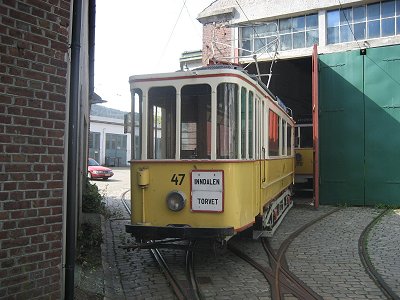 Our
Case study: the vintage tramway project in Bergen, Norway. Our
Case study: the vintage tramway project in Bergen, Norway.
Photo by Bergens Elektriske Sporvei, Bergen, Norway, April 29, 2009.
We
investigate the meaning of vintage tramway and light rail projects.
Our first case study is the 'Electric Tramway' ('Elektriske Sporvei')
of Bergen (Norway). This city hosts a magnificent vintage tramway project.
Construction and planning are well under way. Meanwhile a first portion
of the line is in operation.
Introduction
Nowadays
light rail represents a broad variety of urban rail-bound modes of public
transport. With no exceptions these modes have been invented in the
late 19th or early 20th century. During the last 30-40 years a second
generation of light rail emerged. Though much more advanced the basic
principles of light rail didn't change. Trams are still trams in Europe,
or (again) streetcar in the USA, the country that witnessed the birth
of German-based light rail that performs like a mode called interurban
in the old days. And still we find many regional light railways in countries
like Switzerland and Japan.
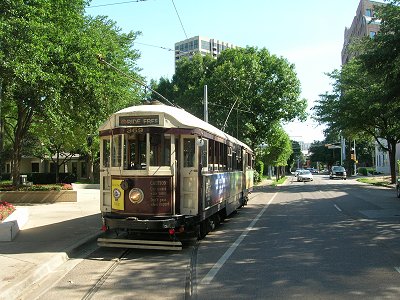
Example:
Dallas (Texas, USA). The McKinney Avenue Transit Authority maintains,
restores and preserves historic trolley cars while educating
the public on the role they played in the development of Dallas. The
vintage line provides a touristic oriented public transport service
within Uptown and Downtown. Photo by Rob van der Bijl, Dallas, Texas,
June 7, 2007.
At
this 'vintage page' of Lightrail.nl the first generation of light rail
is recalled. Our page doesn't serve as nostalgia page, but primarily
as contemporary showcase of historical rail-bound modes which recently
got (or will get) a new life as industrial monument, or moreover as
contribution to the improvement of urban realm and urban life particularly.
In many cities tramways have been reinstalled along former (or sometimes
new) routes and being served by restored vehicles which are maintained
and parked in heritage buildings. The initiators' main purpose with
these tramways is preservation and exhibition of industrial heritage
within a public setting. As a matter of fact the tramways are open museums,
as well as attractions in the public realm. Public transport isn't necessarily
their function.
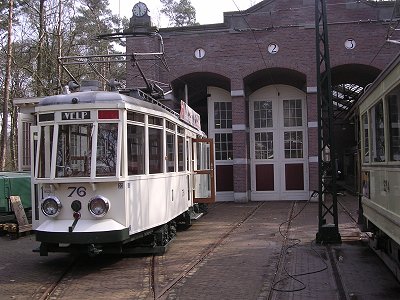
Example:
Arnhem (Netherlands). The vintage tramway of Arnhem (Netherlands) stays
within the boundaries of the Open Air Museum, though potentially an
extension into the city itself would be valuable. Photo by Rob van der
Bijl, Arnhem, Netherlands, March 24, 2005.
Most
examples we studied combine a museum-like presentation with a role as
touristic attraction. We won't present an extensive, let alone comprehensive,
world-wide overview of the existing examples - e.g. Amsterdam (Netherlands),
Bendigo (Australia), Birkenhead (England), Christchurch (New Zealand),
A Coruña (Spain), Dallas (Texas, USA), Edmonton (Canada), Lille
(France), Naumberg (Germany), New Orleans (Louisiana, USA), Porto (Portugal),
Rio de Janeiro (Brazil), San Francisco (California, USA), Sankt Florian
(Austria), Stockholm (Sweden), Thuin (Belgium), Zürich (Switzerland).
In this first edition of our vintage page we shall focus on a case study
we commenced February 2009 in the city of Bergen (Norway).
Bergen is the home of two light rail projects. Under construction is
the 'Bybanen', a cutting edge tramway between the city centre and Nesttun
along the region's most heavily occupied corridor surrounded by mountains
and impressive natural landscape. The system is due to open in summer
of 2010 and various extensions have been envisaged. The other project
is the reconstruction of a former urban tramway line in the old city.
This vintage tramway project is subject of our ongoing case study.
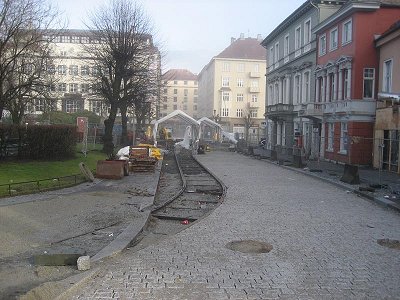 Construction
of the future terminus at Engen, city centre.
Construction
of the future terminus at Engen, city centre.
Photo by Bergens Elektriske Sporvei, Bergen, Norway, February 10, 2008.
Case
study
The 'Bergen's Electric Tramway' ('Bergens Elektriske Sporvei') is a
non-profit organisation. Since 1993 this organisation has operated from
the Bergen Technical Museum which is housed in the old tram workshop
at Møhlenpris. The aim of the group is to restore the former
tramline 3 (opened in 1911 and closed in 1950) that ran from Møhlenpris
to the city centre and Engen. The length of the planned vintage line
is 1,5 km and will be operated as a museum tramway.
The vintage tramway project is supported by the City Council, which
favours its completion. The initiators have appointed with the local
administration to allow installation of tracks in the street when integrated
in planned and ongoing reconstruction of the public realm. Once a street
section is newly paved the tracks are installed as part of the very
same work.
Five independent sections with a total length of 850 meters have been
completed so far including the first 400 meters from the depot. It is
hoped that the first two sections can be joined later this year (2009),
so that operation can be extended from the depot to the Student Centre
at Olaf Ryes vei in the University area. Phase 2 will bring the vintage
tramway into the centre Bergen at Engen. Hence further extensions will
join together the other finished sections and will complete the line
to the 'Den Nationale Scene'. For the far future ambitious plans have
been envisaged to rebuild the tramway to Bryggen, St Mary's Church,
Nordnes, Bergen Aquarium and VilVite, the Bergen Science Centre. It
may also be possible to connect the museum tramway to the new light
rail system allowing vintage tram operations on special occasions.
Second-hand trams from Berlin (type Reko) were acquired in 1996 and
will be used to operate phase 1. The depot also hosts a historical tram
from the old system of Bergen (1897), as well as a 1913 two-axle Oslo
tram pending restoration.
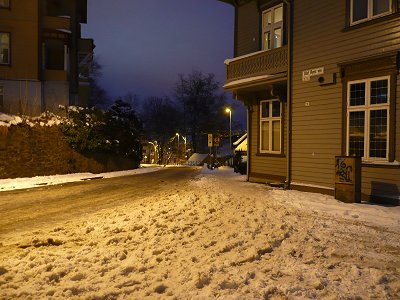
Winter impression.
Tracks covered by snow. Photo by Rob van der Bijl, Bergen, Norway, February
12, 2009.
Impressions
In February 2009 we made our first inspection, hosted by Thomas Potter
and Jimmy Schmincke. Though, the rails were covered with snow we could
easily trace the route and its alignment. From the depot/museum about
400 meter of tracks are wired and in operation. Beyond the temporary
terminus we walked along recently installed tracks. Tom pointed to an
open air storage of rails. "We got these rails from Trondheim.
These rails were purchased about 20 years ago for an extension which
was never built." After a small gap we witnessed a newly reestablished
section of tramway. "These parked cars on the gutter alignment
will be removed once our tram is running," Thomas smiled. After
a steep climb an impressive and romantic portion of the route allows
a view on the city centre down the hill. "And the terminus of
the new light rail", Jimmy Schmincke added. At the top of the
hill the tramway will pass the San Giovanni church (Johanneskirken).
We continued and were amazed by the glass façade of the modern
swimming pool of the new student centre that will serve as background
of the terminus of phase 1. We continued and were impressed by the vast
amount of track already being installed in the section of phase 2. We
loved the fine atmosphere of Engen that will serve as the final terminus
of the tramway in the very heart of Bergen's historical centre. We loved
the beer too in the Café Henrik, on the first floor that allowed
a fine view of the elegant bow of the vintage tramway in the renewed
public realm of Engen. "We are eager to finish this project",
said Thomas. And we are too, cheers!
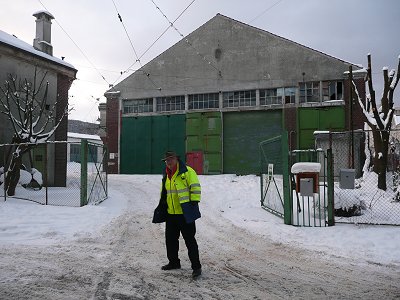
Winter impression.
Thomas Potter in front of the depot. Photo by Rob van der Bijl, Bergen,
Norway, February 12, 2009.
Links
=Bergens Elektriske Sporvei - www.besporvei.net
=Bybanen Bergen Light Rail - www.bybanen.no
=Light Rail Atlas' historic page - LRA
HISTORY
Acknowledgments
Thomas Potter, Jimmy Schmincke, Knut Serigstad, Atle Ingebrigtsen.
Information
RVDB/Lightrail.nl/ offers information on this page and interesting vintage
projects. Please mail Rob
van der Bijl
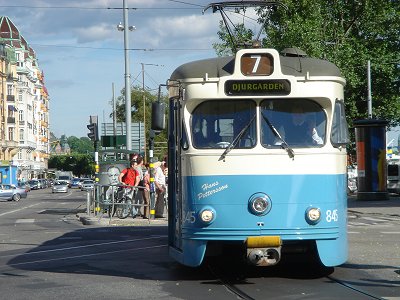
Case study
#2: Stockholm (Sweden). The Djurgärdenbanan is due to be transformed
to contemporary light rail, though the museum and touristic function
will remain. Photo by Jaap Modder, Stockholm, Sweden, June 25, 2005.
Next
case study
This vintage tramway runs between Norrmalmstorg and Waldemarsudde in
central Stockholm. The tramway will be part of a new cutting edge urban
tramway system. This proves vintage tramways can develop into real public
transport too. This is the reason while Stockholm serves as our second
case study. To be continued…
(C)
Dr. ir. Rob A.J.van der Bijl, Amsterdam, Netherlands, 2009
|
 Our
Case study: the vintage tramway project in Bergen, Norway.
Our
Case study: the vintage tramway project in Bergen, Norway.

 Construction
of the future terminus at Engen, city centre.
Construction
of the future terminus at Engen, city centre.

